Marks & Spencer: Leader, Manager Roles, Operational Management Report
VerifiedAdded on 2020/10/05
|14
|4403
|273
Report
AI Summary
This report provides a comprehensive analysis of leadership and management practices within Marks & Spencer (M&S), a British multinational retailer. The report begins with an introduction to M&S's organizational structure and defines the roles and characteristics of leaders and managers. It then contrasts managerial functions with leadership roles, applying various management concepts and theories, including contemporary, classical, and contingency theories. The report explores the roles of leaders and managers in different situational contexts, discussing leadership and management theories such as situational, systematic, and contingency leadership, as well as administrative and scientific management theories. Furthermore, the report delves into the strengths and weaknesses of these approaches. The second part of the report focuses on operational management, outlining key approaches like Six Sigma and their application within M&S. It examines the roles and responsibilities of managers and leaders in operational management, the importance of these approaches in achieving organizational goals, and how managers and leaders can improve operational efficiencies. The report also analyzes the impact of the external business environment on operational decisions and concludes with recommendations for further improvements in leadership and management practices at M&S.
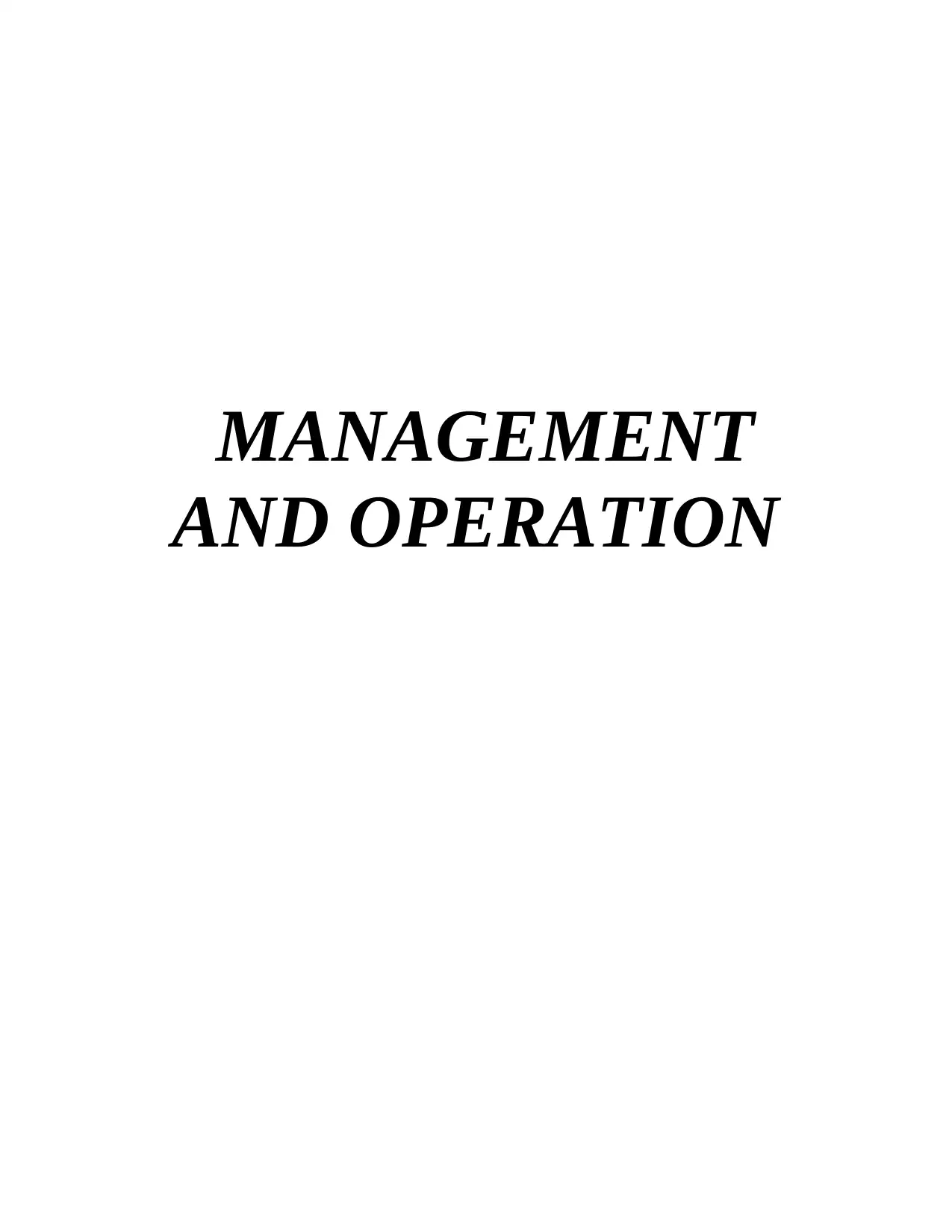
MANAGEMENT
AND OPERATION
AND OPERATION
Paraphrase This Document
Need a fresh take? Get an instant paraphrase of this document with our AI Paraphraser
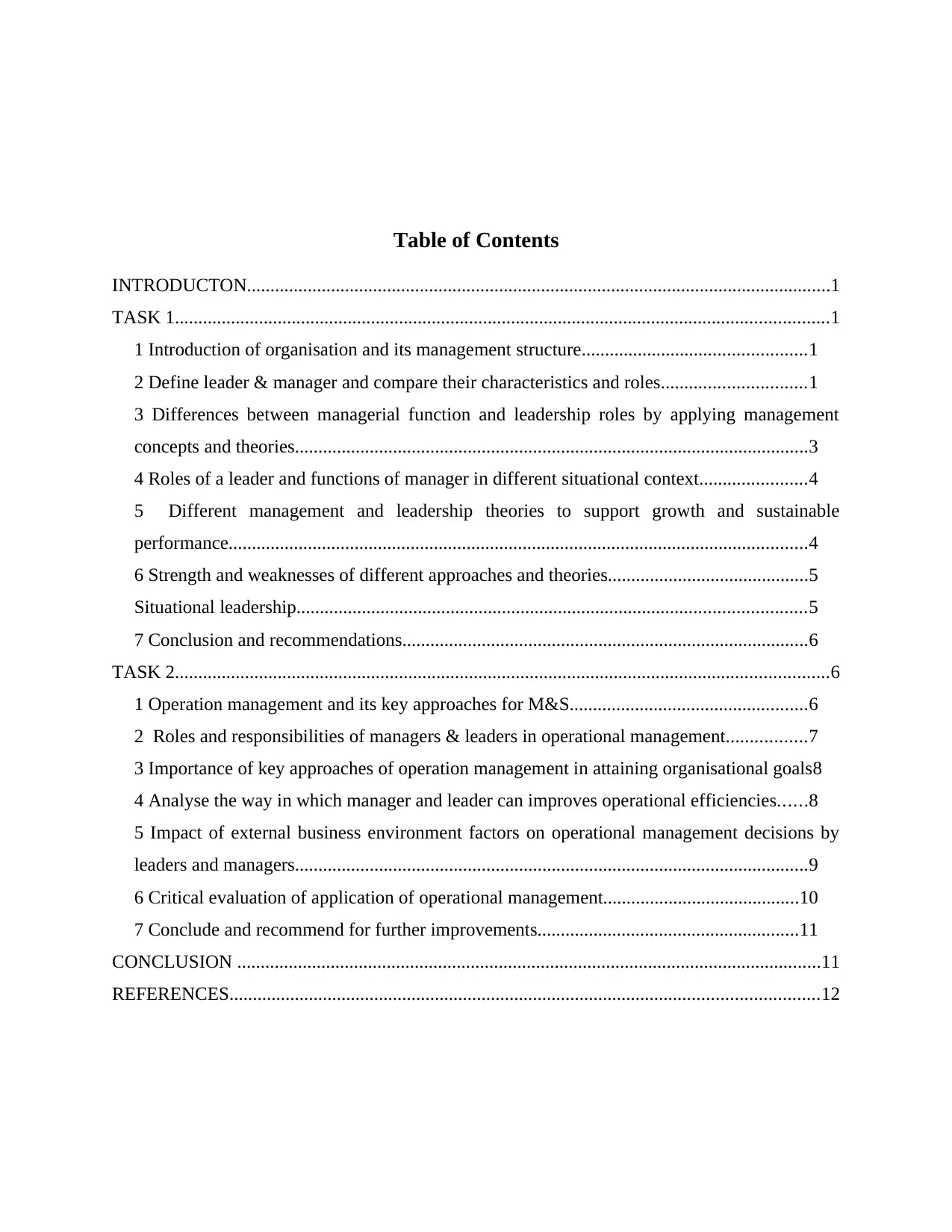
Table of Contents
INTRODUCTON.............................................................................................................................1
TASK 1............................................................................................................................................1
1 Introduction of organisation and its management structure................................................1
2 Define leader & manager and compare their characteristics and roles...............................1
3 Differences between managerial function and leadership roles by applying management
concepts and theories..............................................................................................................3
4 Roles of a leader and functions of manager in different situational context.......................4
5 Different management and leadership theories to support growth and sustainable
performance............................................................................................................................4
6 Strength and weaknesses of different approaches and theories...........................................5
Situational leadership.............................................................................................................5
7 Conclusion and recommendations.......................................................................................6
TASK 2............................................................................................................................................6
1 Operation management and its key approaches for M&S...................................................6
2 Roles and responsibilities of managers & leaders in operational management.................7
3 Importance of key approaches of operation management in attaining organisational goals8
4 Analyse the way in which manager and leader can improves operational efficiencies......8
5 Impact of external business environment factors on operational management decisions by
leaders and managers..............................................................................................................9
6 Critical evaluation of application of operational management..........................................10
7 Conclude and recommend for further improvements........................................................11
CONCLUSION .............................................................................................................................11
REFERENCES..............................................................................................................................12
INTRODUCTON.............................................................................................................................1
TASK 1............................................................................................................................................1
1 Introduction of organisation and its management structure................................................1
2 Define leader & manager and compare their characteristics and roles...............................1
3 Differences between managerial function and leadership roles by applying management
concepts and theories..............................................................................................................3
4 Roles of a leader and functions of manager in different situational context.......................4
5 Different management and leadership theories to support growth and sustainable
performance............................................................................................................................4
6 Strength and weaknesses of different approaches and theories...........................................5
Situational leadership.............................................................................................................5
7 Conclusion and recommendations.......................................................................................6
TASK 2............................................................................................................................................6
1 Operation management and its key approaches for M&S...................................................6
2 Roles and responsibilities of managers & leaders in operational management.................7
3 Importance of key approaches of operation management in attaining organisational goals8
4 Analyse the way in which manager and leader can improves operational efficiencies......8
5 Impact of external business environment factors on operational management decisions by
leaders and managers..............................................................................................................9
6 Critical evaluation of application of operational management..........................................10
7 Conclude and recommend for further improvements........................................................11
CONCLUSION .............................................................................................................................11
REFERENCES..............................................................................................................................12
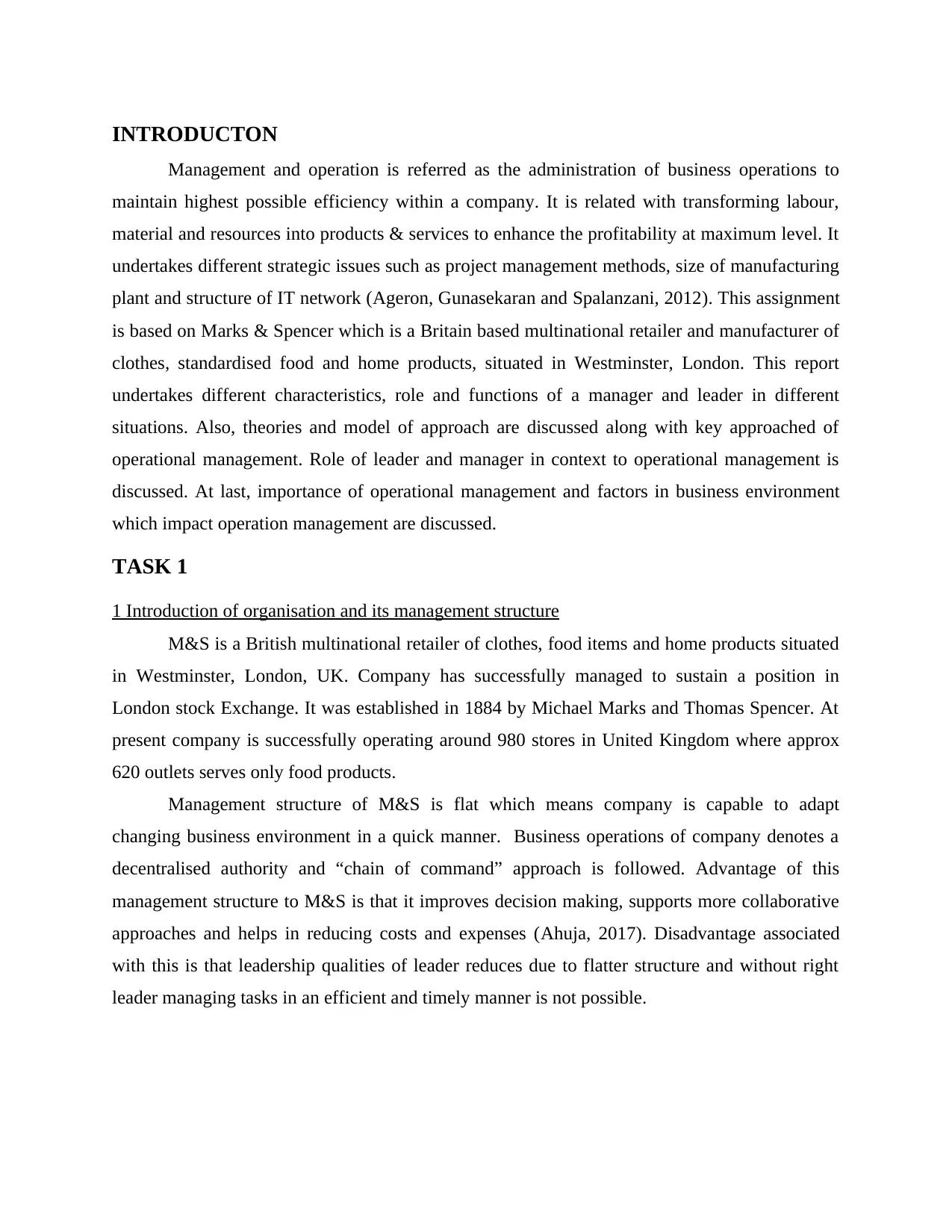
INTRODUCTON
Management and operation is referred as the administration of business operations to
maintain highest possible efficiency within a company. It is related with transforming labour,
material and resources into products & services to enhance the profitability at maximum level. It
undertakes different strategic issues such as project management methods, size of manufacturing
plant and structure of IT network (Ageron, Gunasekaran and Spalanzani, 2012). This assignment
is based on Marks & Spencer which is a Britain based multinational retailer and manufacturer of
clothes, standardised food and home products, situated in Westminster, London. This report
undertakes different characteristics, role and functions of a manager and leader in different
situations. Also, theories and model of approach are discussed along with key approached of
operational management. Role of leader and manager in context to operational management is
discussed. At last, importance of operational management and factors in business environment
which impact operation management are discussed.
TASK 1
1 Introduction of organisation and its management structure
M&S is a British multinational retailer of clothes, food items and home products situated
in Westminster, London, UK. Company has successfully managed to sustain a position in
London stock Exchange. It was established in 1884 by Michael Marks and Thomas Spencer. At
present company is successfully operating around 980 stores in United Kingdom where approx
620 outlets serves only food products.
Management structure of M&S is flat which means company is capable to adapt
changing business environment in a quick manner. Business operations of company denotes a
decentralised authority and “chain of command” approach is followed. Advantage of this
management structure to M&S is that it improves decision making, supports more collaborative
approaches and helps in reducing costs and expenses (Ahuja, 2017). Disadvantage associated
with this is that leadership qualities of leader reduces due to flatter structure and without right
leader managing tasks in an efficient and timely manner is not possible.
Management and operation is referred as the administration of business operations to
maintain highest possible efficiency within a company. It is related with transforming labour,
material and resources into products & services to enhance the profitability at maximum level. It
undertakes different strategic issues such as project management methods, size of manufacturing
plant and structure of IT network (Ageron, Gunasekaran and Spalanzani, 2012). This assignment
is based on Marks & Spencer which is a Britain based multinational retailer and manufacturer of
clothes, standardised food and home products, situated in Westminster, London. This report
undertakes different characteristics, role and functions of a manager and leader in different
situations. Also, theories and model of approach are discussed along with key approached of
operational management. Role of leader and manager in context to operational management is
discussed. At last, importance of operational management and factors in business environment
which impact operation management are discussed.
TASK 1
1 Introduction of organisation and its management structure
M&S is a British multinational retailer of clothes, food items and home products situated
in Westminster, London, UK. Company has successfully managed to sustain a position in
London stock Exchange. It was established in 1884 by Michael Marks and Thomas Spencer. At
present company is successfully operating around 980 stores in United Kingdom where approx
620 outlets serves only food products.
Management structure of M&S is flat which means company is capable to adapt
changing business environment in a quick manner. Business operations of company denotes a
decentralised authority and “chain of command” approach is followed. Advantage of this
management structure to M&S is that it improves decision making, supports more collaborative
approaches and helps in reducing costs and expenses (Ahuja, 2017). Disadvantage associated
with this is that leadership qualities of leader reduces due to flatter structure and without right
leader managing tasks in an efficient and timely manner is not possible.
⊘ This is a preview!⊘
Do you want full access?
Subscribe today to unlock all pages.

Trusted by 1+ million students worldwide
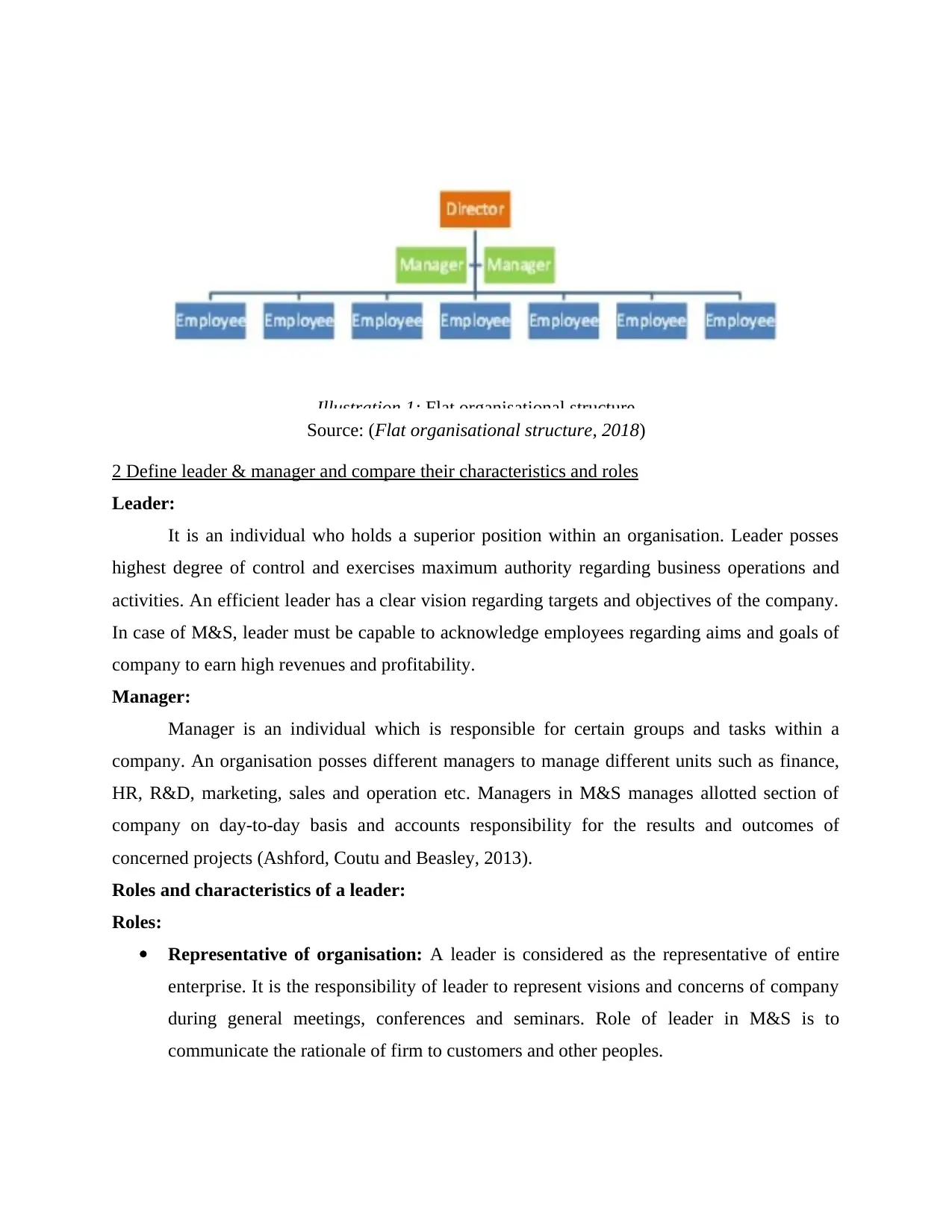
Source: (Flat organisational structure, 2018)
2 Define leader & manager and compare their characteristics and roles
Leader:
It is an individual who holds a superior position within an organisation. Leader posses
highest degree of control and exercises maximum authority regarding business operations and
activities. An efficient leader has a clear vision regarding targets and objectives of the company.
In case of M&S, leader must be capable to acknowledge employees regarding aims and goals of
company to earn high revenues and profitability.
Manager:
Manager is an individual which is responsible for certain groups and tasks within a
company. An organisation posses different managers to manage different units such as finance,
HR, R&D, marketing, sales and operation etc. Managers in M&S manages allotted section of
company on day-to-day basis and accounts responsibility for the results and outcomes of
concerned projects (Ashford, Coutu and Beasley, 2013).
Roles and characteristics of a leader:
Roles:
Representative of organisation: A leader is considered as the representative of entire
enterprise. It is the responsibility of leader to represent visions and concerns of company
during general meetings, conferences and seminars. Role of leader in M&S is to
communicate the rationale of firm to customers and other peoples.
Illustration 1: Flat organisational structure
2 Define leader & manager and compare their characteristics and roles
Leader:
It is an individual who holds a superior position within an organisation. Leader posses
highest degree of control and exercises maximum authority regarding business operations and
activities. An efficient leader has a clear vision regarding targets and objectives of the company.
In case of M&S, leader must be capable to acknowledge employees regarding aims and goals of
company to earn high revenues and profitability.
Manager:
Manager is an individual which is responsible for certain groups and tasks within a
company. An organisation posses different managers to manage different units such as finance,
HR, R&D, marketing, sales and operation etc. Managers in M&S manages allotted section of
company on day-to-day basis and accounts responsibility for the results and outcomes of
concerned projects (Ashford, Coutu and Beasley, 2013).
Roles and characteristics of a leader:
Roles:
Representative of organisation: A leader is considered as the representative of entire
enterprise. It is the responsibility of leader to represent visions and concerns of company
during general meetings, conferences and seminars. Role of leader in M&S is to
communicate the rationale of firm to customers and other peoples.
Illustration 1: Flat organisational structure
Paraphrase This Document
Need a fresh take? Get an instant paraphrase of this document with our AI Paraphraser
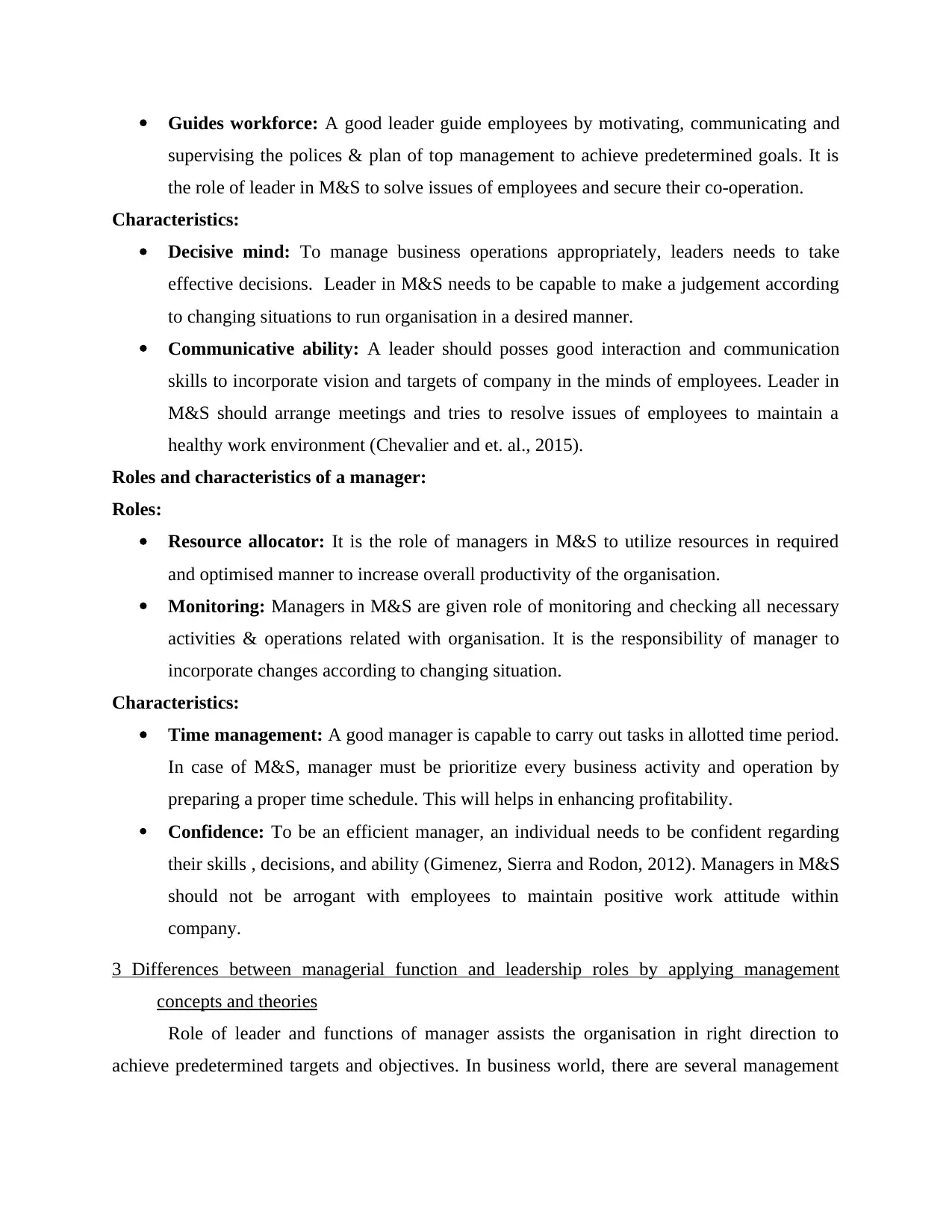
Guides workforce: A good leader guide employees by motivating, communicating and
supervising the polices & plan of top management to achieve predetermined goals. It is
the role of leader in M&S to solve issues of employees and secure their co-operation.
Characteristics:
Decisive mind: To manage business operations appropriately, leaders needs to take
effective decisions. Leader in M&S needs to be capable to make a judgement according
to changing situations to run organisation in a desired manner.
Communicative ability: A leader should posses good interaction and communication
skills to incorporate vision and targets of company in the minds of employees. Leader in
M&S should arrange meetings and tries to resolve issues of employees to maintain a
healthy work environment (Chevalier and et. al., 2015).
Roles and characteristics of a manager:
Roles:
Resource allocator: It is the role of managers in M&S to utilize resources in required
and optimised manner to increase overall productivity of the organisation.
Monitoring: Managers in M&S are given role of monitoring and checking all necessary
activities & operations related with organisation. It is the responsibility of manager to
incorporate changes according to changing situation.
Characteristics:
Time management: A good manager is capable to carry out tasks in allotted time period.
In case of M&S, manager must be prioritize every business activity and operation by
preparing a proper time schedule. This will helps in enhancing profitability.
Confidence: To be an efficient manager, an individual needs to be confident regarding
their skills , decisions, and ability (Gimenez, Sierra and Rodon, 2012). Managers in M&S
should not be arrogant with employees to maintain positive work attitude within
company.
3 Differences between managerial function and leadership roles by applying management
concepts and theories
Role of leader and functions of manager assists the organisation in right direction to
achieve predetermined targets and objectives. In business world, there are several management
supervising the polices & plan of top management to achieve predetermined goals. It is
the role of leader in M&S to solve issues of employees and secure their co-operation.
Characteristics:
Decisive mind: To manage business operations appropriately, leaders needs to take
effective decisions. Leader in M&S needs to be capable to make a judgement according
to changing situations to run organisation in a desired manner.
Communicative ability: A leader should posses good interaction and communication
skills to incorporate vision and targets of company in the minds of employees. Leader in
M&S should arrange meetings and tries to resolve issues of employees to maintain a
healthy work environment (Chevalier and et. al., 2015).
Roles and characteristics of a manager:
Roles:
Resource allocator: It is the role of managers in M&S to utilize resources in required
and optimised manner to increase overall productivity of the organisation.
Monitoring: Managers in M&S are given role of monitoring and checking all necessary
activities & operations related with organisation. It is the responsibility of manager to
incorporate changes according to changing situation.
Characteristics:
Time management: A good manager is capable to carry out tasks in allotted time period.
In case of M&S, manager must be prioritize every business activity and operation by
preparing a proper time schedule. This will helps in enhancing profitability.
Confidence: To be an efficient manager, an individual needs to be confident regarding
their skills , decisions, and ability (Gimenez, Sierra and Rodon, 2012). Managers in M&S
should not be arrogant with employees to maintain positive work attitude within
company.
3 Differences between managerial function and leadership roles by applying management
concepts and theories
Role of leader and functions of manager assists the organisation in right direction to
achieve predetermined targets and objectives. In business world, there are several management
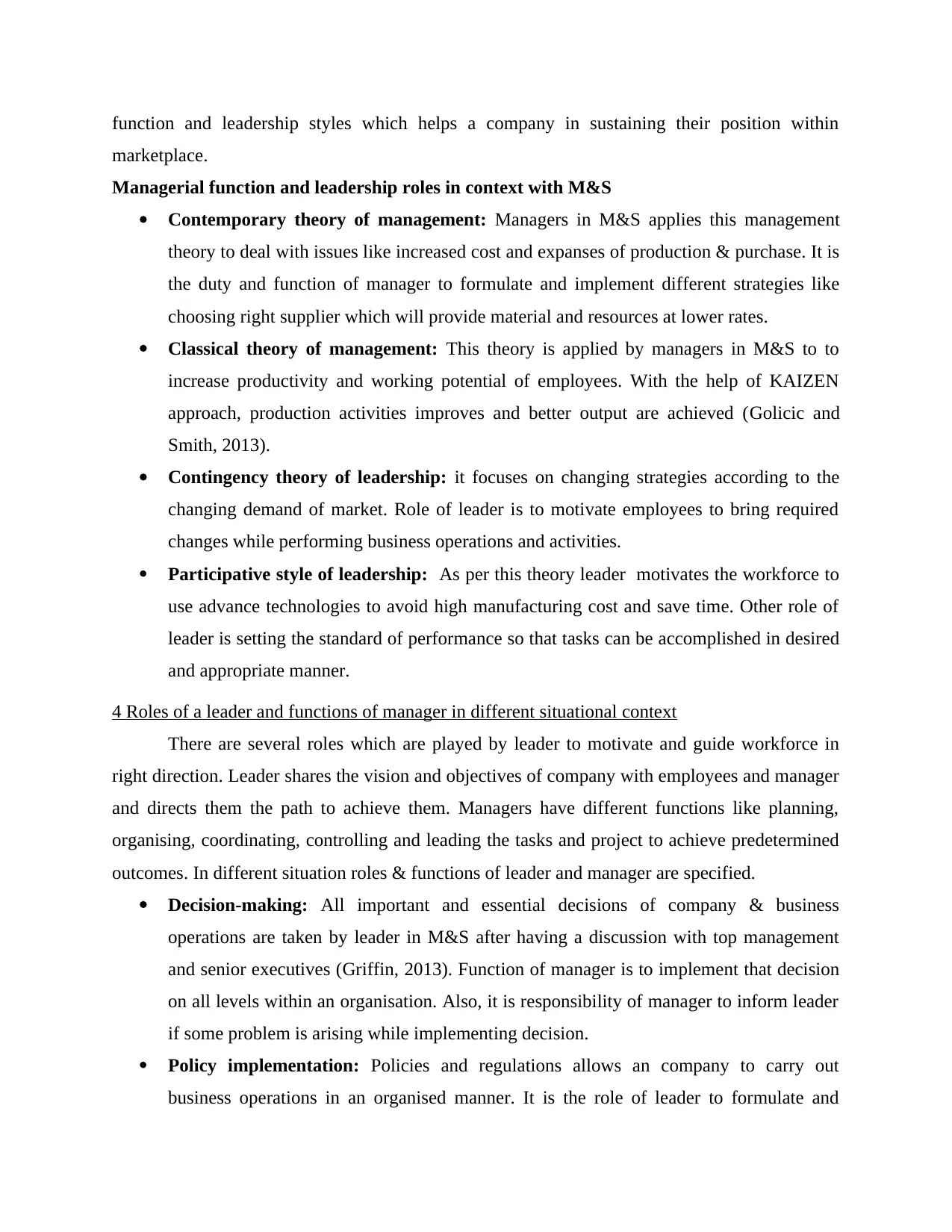
function and leadership styles which helps a company in sustaining their position within
marketplace.
Managerial function and leadership roles in context with M&S
Contemporary theory of management: Managers in M&S applies this management
theory to deal with issues like increased cost and expanses of production & purchase. It is
the duty and function of manager to formulate and implement different strategies like
choosing right supplier which will provide material and resources at lower rates.
Classical theory of management: This theory is applied by managers in M&S to to
increase productivity and working potential of employees. With the help of KAIZEN
approach, production activities improves and better output are achieved (Golicic and
Smith, 2013).
Contingency theory of leadership: it focuses on changing strategies according to the
changing demand of market. Role of leader is to motivate employees to bring required
changes while performing business operations and activities.
Participative style of leadership: As per this theory leader motivates the workforce to
use advance technologies to avoid high manufacturing cost and save time. Other role of
leader is setting the standard of performance so that tasks can be accomplished in desired
and appropriate manner.
4 Roles of a leader and functions of manager in different situational context
There are several roles which are played by leader to motivate and guide workforce in
right direction. Leader shares the vision and objectives of company with employees and manager
and directs them the path to achieve them. Managers have different functions like planning,
organising, coordinating, controlling and leading the tasks and project to achieve predetermined
outcomes. In different situation roles & functions of leader and manager are specified.
Decision-making: All important and essential decisions of company & business
operations are taken by leader in M&S after having a discussion with top management
and senior executives (Griffin, 2013). Function of manager is to implement that decision
on all levels within an organisation. Also, it is responsibility of manager to inform leader
if some problem is arising while implementing decision.
Policy implementation: Policies and regulations allows an company to carry out
business operations in an organised manner. It is the role of leader to formulate and
marketplace.
Managerial function and leadership roles in context with M&S
Contemporary theory of management: Managers in M&S applies this management
theory to deal with issues like increased cost and expanses of production & purchase. It is
the duty and function of manager to formulate and implement different strategies like
choosing right supplier which will provide material and resources at lower rates.
Classical theory of management: This theory is applied by managers in M&S to to
increase productivity and working potential of employees. With the help of KAIZEN
approach, production activities improves and better output are achieved (Golicic and
Smith, 2013).
Contingency theory of leadership: it focuses on changing strategies according to the
changing demand of market. Role of leader is to motivate employees to bring required
changes while performing business operations and activities.
Participative style of leadership: As per this theory leader motivates the workforce to
use advance technologies to avoid high manufacturing cost and save time. Other role of
leader is setting the standard of performance so that tasks can be accomplished in desired
and appropriate manner.
4 Roles of a leader and functions of manager in different situational context
There are several roles which are played by leader to motivate and guide workforce in
right direction. Leader shares the vision and objectives of company with employees and manager
and directs them the path to achieve them. Managers have different functions like planning,
organising, coordinating, controlling and leading the tasks and project to achieve predetermined
outcomes. In different situation roles & functions of leader and manager are specified.
Decision-making: All important and essential decisions of company & business
operations are taken by leader in M&S after having a discussion with top management
and senior executives (Griffin, 2013). Function of manager is to implement that decision
on all levels within an organisation. Also, it is responsibility of manager to inform leader
if some problem is arising while implementing decision.
Policy implementation: Policies and regulations allows an company to carry out
business operations in an organised manner. It is the role of leader to formulate and
⊘ This is a preview!⊘
Do you want full access?
Subscribe today to unlock all pages.

Trusted by 1+ million students worldwide
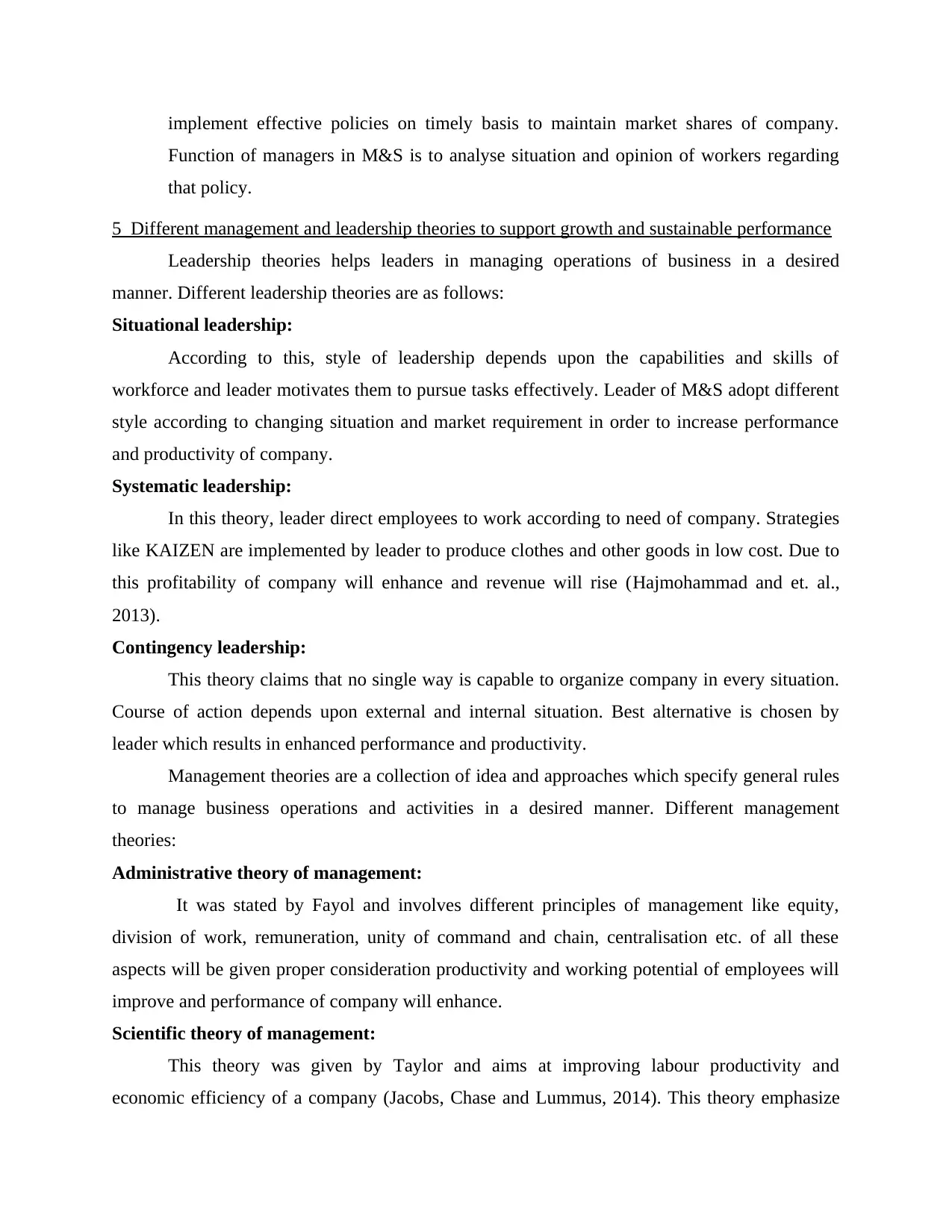
implement effective policies on timely basis to maintain market shares of company.
Function of managers in M&S is to analyse situation and opinion of workers regarding
that policy.
5 Different management and leadership theories to support growth and sustainable performance
Leadership theories helps leaders in managing operations of business in a desired
manner. Different leadership theories are as follows:
Situational leadership:
According to this, style of leadership depends upon the capabilities and skills of
workforce and leader motivates them to pursue tasks effectively. Leader of M&S adopt different
style according to changing situation and market requirement in order to increase performance
and productivity of company.
Systematic leadership:
In this theory, leader direct employees to work according to need of company. Strategies
like KAIZEN are implemented by leader to produce clothes and other goods in low cost. Due to
this profitability of company will enhance and revenue will rise (Hajmohammad and et. al.,
2013).
Contingency leadership:
This theory claims that no single way is capable to organize company in every situation.
Course of action depends upon external and internal situation. Best alternative is chosen by
leader which results in enhanced performance and productivity.
Management theories are a collection of idea and approaches which specify general rules
to manage business operations and activities in a desired manner. Different management
theories:
Administrative theory of management:
It was stated by Fayol and involves different principles of management like equity,
division of work, remuneration, unity of command and chain, centralisation etc. of all these
aspects will be given proper consideration productivity and working potential of employees will
improve and performance of company will enhance.
Scientific theory of management:
This theory was given by Taylor and aims at improving labour productivity and
economic efficiency of a company (Jacobs, Chase and Lummus, 2014). This theory emphasize
Function of managers in M&S is to analyse situation and opinion of workers regarding
that policy.
5 Different management and leadership theories to support growth and sustainable performance
Leadership theories helps leaders in managing operations of business in a desired
manner. Different leadership theories are as follows:
Situational leadership:
According to this, style of leadership depends upon the capabilities and skills of
workforce and leader motivates them to pursue tasks effectively. Leader of M&S adopt different
style according to changing situation and market requirement in order to increase performance
and productivity of company.
Systematic leadership:
In this theory, leader direct employees to work according to need of company. Strategies
like KAIZEN are implemented by leader to produce clothes and other goods in low cost. Due to
this profitability of company will enhance and revenue will rise (Hajmohammad and et. al.,
2013).
Contingency leadership:
This theory claims that no single way is capable to organize company in every situation.
Course of action depends upon external and internal situation. Best alternative is chosen by
leader which results in enhanced performance and productivity.
Management theories are a collection of idea and approaches which specify general rules
to manage business operations and activities in a desired manner. Different management
theories:
Administrative theory of management:
It was stated by Fayol and involves different principles of management like equity,
division of work, remuneration, unity of command and chain, centralisation etc. of all these
aspects will be given proper consideration productivity and working potential of employees will
improve and performance of company will enhance.
Scientific theory of management:
This theory was given by Taylor and aims at improving labour productivity and
economic efficiency of a company (Jacobs, Chase and Lummus, 2014). This theory emphasize
Paraphrase This Document
Need a fresh take? Get an instant paraphrase of this document with our AI Paraphraser
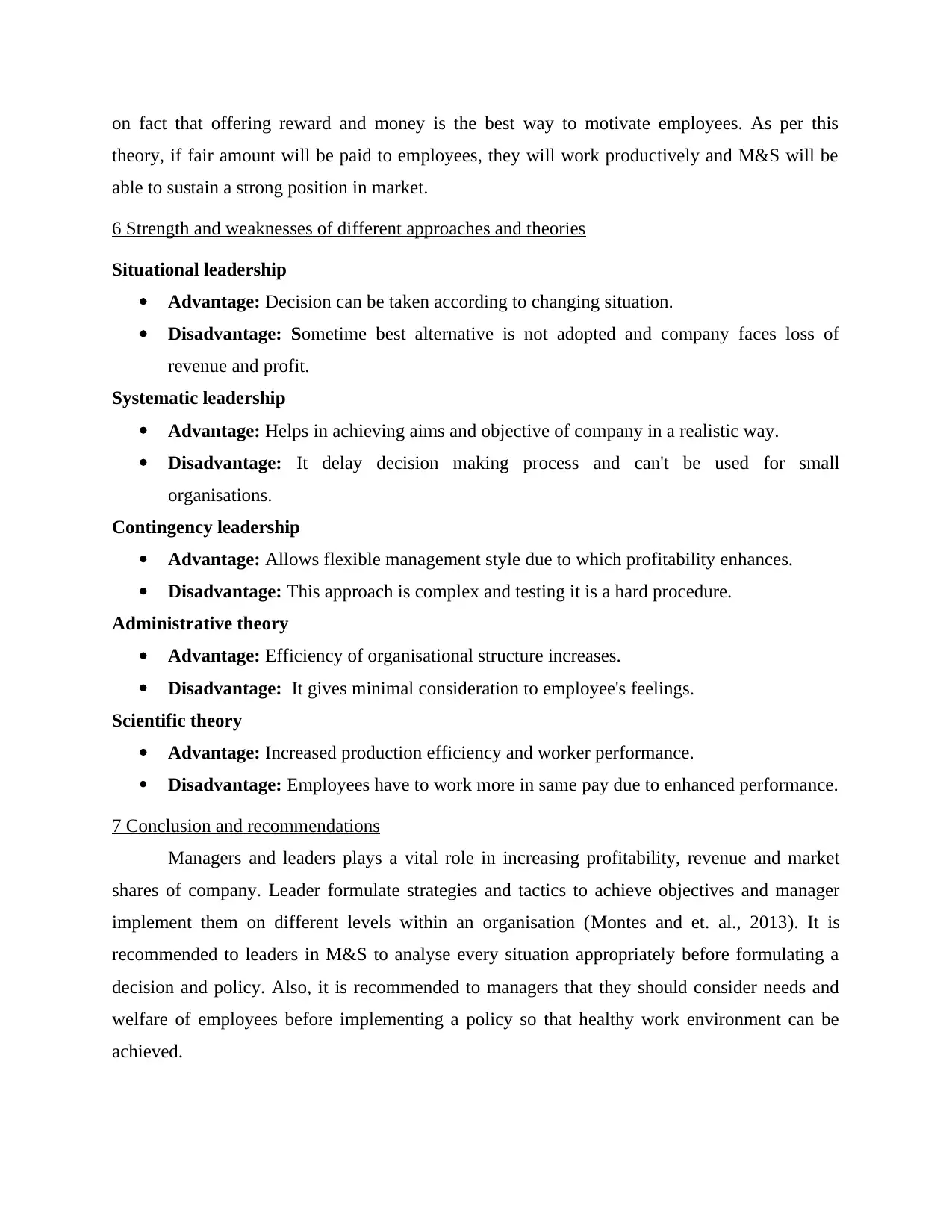
on fact that offering reward and money is the best way to motivate employees. As per this
theory, if fair amount will be paid to employees, they will work productively and M&S will be
able to sustain a strong position in market.
6 Strength and weaknesses of different approaches and theories
Situational leadership
Advantage: Decision can be taken according to changing situation.
Disadvantage: Sometime best alternative is not adopted and company faces loss of
revenue and profit.
Systematic leadership
Advantage: Helps in achieving aims and objective of company in a realistic way.
Disadvantage: It delay decision making process and can't be used for small
organisations.
Contingency leadership
Advantage: Allows flexible management style due to which profitability enhances.
Disadvantage: This approach is complex and testing it is a hard procedure.
Administrative theory
Advantage: Efficiency of organisational structure increases.
Disadvantage: It gives minimal consideration to employee's feelings.
Scientific theory
Advantage: Increased production efficiency and worker performance.
Disadvantage: Employees have to work more in same pay due to enhanced performance.
7 Conclusion and recommendations
Managers and leaders plays a vital role in increasing profitability, revenue and market
shares of company. Leader formulate strategies and tactics to achieve objectives and manager
implement them on different levels within an organisation (Montes and et. al., 2013). It is
recommended to leaders in M&S to analyse every situation appropriately before formulating a
decision and policy. Also, it is recommended to managers that they should consider needs and
welfare of employees before implementing a policy so that healthy work environment can be
achieved.
theory, if fair amount will be paid to employees, they will work productively and M&S will be
able to sustain a strong position in market.
6 Strength and weaknesses of different approaches and theories
Situational leadership
Advantage: Decision can be taken according to changing situation.
Disadvantage: Sometime best alternative is not adopted and company faces loss of
revenue and profit.
Systematic leadership
Advantage: Helps in achieving aims and objective of company in a realistic way.
Disadvantage: It delay decision making process and can't be used for small
organisations.
Contingency leadership
Advantage: Allows flexible management style due to which profitability enhances.
Disadvantage: This approach is complex and testing it is a hard procedure.
Administrative theory
Advantage: Efficiency of organisational structure increases.
Disadvantage: It gives minimal consideration to employee's feelings.
Scientific theory
Advantage: Increased production efficiency and worker performance.
Disadvantage: Employees have to work more in same pay due to enhanced performance.
7 Conclusion and recommendations
Managers and leaders plays a vital role in increasing profitability, revenue and market
shares of company. Leader formulate strategies and tactics to achieve objectives and manager
implement them on different levels within an organisation (Montes and et. al., 2013). It is
recommended to leaders in M&S to analyse every situation appropriately before formulating a
decision and policy. Also, it is recommended to managers that they should consider needs and
welfare of employees before implementing a policy so that healthy work environment can be
achieved.
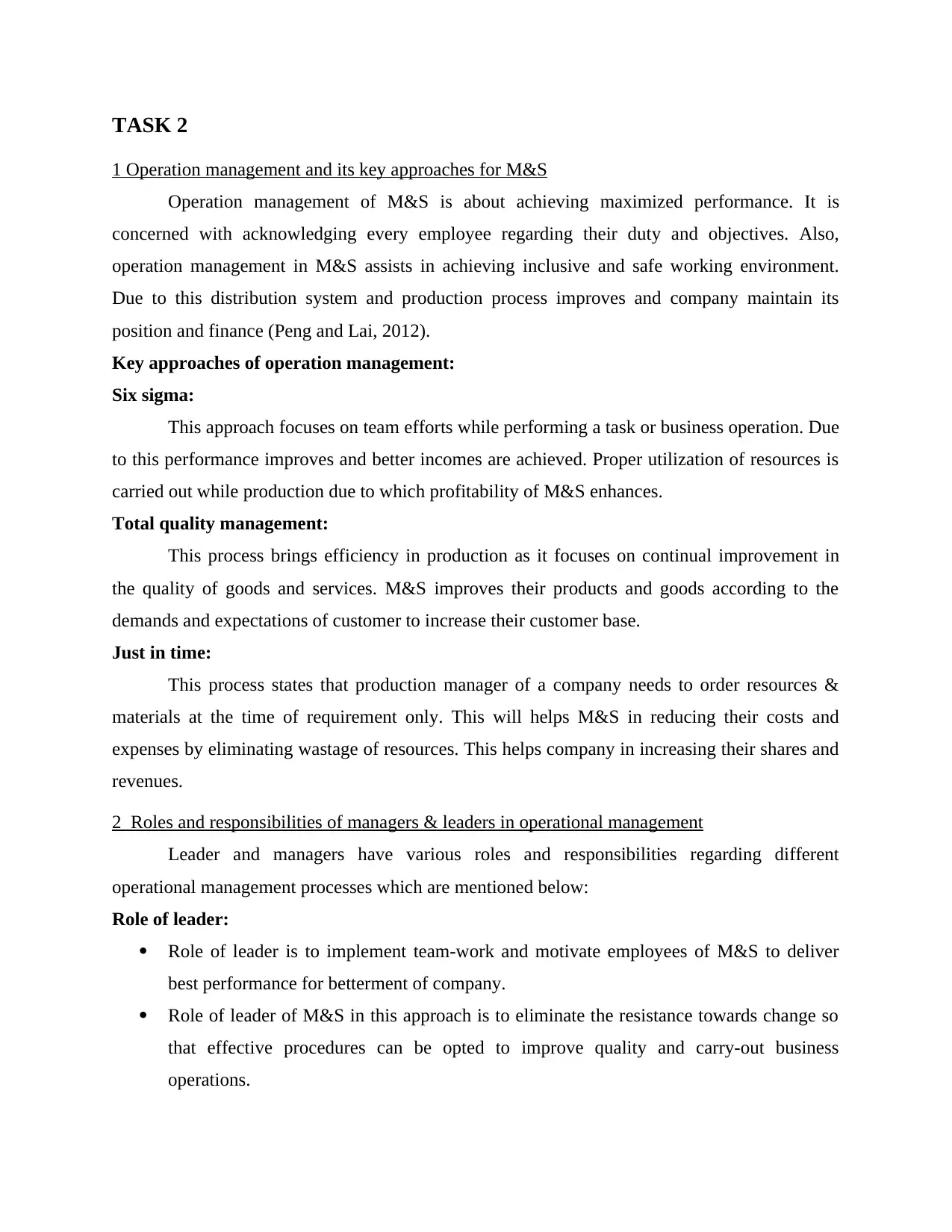
TASK 2
1 Operation management and its key approaches for M&S
Operation management of M&S is about achieving maximized performance. It is
concerned with acknowledging every employee regarding their duty and objectives. Also,
operation management in M&S assists in achieving inclusive and safe working environment.
Due to this distribution system and production process improves and company maintain its
position and finance (Peng and Lai, 2012).
Key approaches of operation management:
Six sigma:
This approach focuses on team efforts while performing a task or business operation. Due
to this performance improves and better incomes are achieved. Proper utilization of resources is
carried out while production due to which profitability of M&S enhances.
Total quality management:
This process brings efficiency in production as it focuses on continual improvement in
the quality of goods and services. M&S improves their products and goods according to the
demands and expectations of customer to increase their customer base.
Just in time:
This process states that production manager of a company needs to order resources &
materials at the time of requirement only. This will helps M&S in reducing their costs and
expenses by eliminating wastage of resources. This helps company in increasing their shares and
revenues.
2 Roles and responsibilities of managers & leaders in operational management
Leader and managers have various roles and responsibilities regarding different
operational management processes which are mentioned below:
Role of leader:
Role of leader is to implement team-work and motivate employees of M&S to deliver
best performance for betterment of company.
Role of leader of M&S in this approach is to eliminate the resistance towards change so
that effective procedures can be opted to improve quality and carry-out business
operations.
1 Operation management and its key approaches for M&S
Operation management of M&S is about achieving maximized performance. It is
concerned with acknowledging every employee regarding their duty and objectives. Also,
operation management in M&S assists in achieving inclusive and safe working environment.
Due to this distribution system and production process improves and company maintain its
position and finance (Peng and Lai, 2012).
Key approaches of operation management:
Six sigma:
This approach focuses on team efforts while performing a task or business operation. Due
to this performance improves and better incomes are achieved. Proper utilization of resources is
carried out while production due to which profitability of M&S enhances.
Total quality management:
This process brings efficiency in production as it focuses on continual improvement in
the quality of goods and services. M&S improves their products and goods according to the
demands and expectations of customer to increase their customer base.
Just in time:
This process states that production manager of a company needs to order resources &
materials at the time of requirement only. This will helps M&S in reducing their costs and
expenses by eliminating wastage of resources. This helps company in increasing their shares and
revenues.
2 Roles and responsibilities of managers & leaders in operational management
Leader and managers have various roles and responsibilities regarding different
operational management processes which are mentioned below:
Role of leader:
Role of leader is to implement team-work and motivate employees of M&S to deliver
best performance for betterment of company.
Role of leader of M&S in this approach is to eliminate the resistance towards change so
that effective procedures can be opted to improve quality and carry-out business
operations.
⊘ This is a preview!⊘
Do you want full access?
Subscribe today to unlock all pages.

Trusted by 1+ million students worldwide
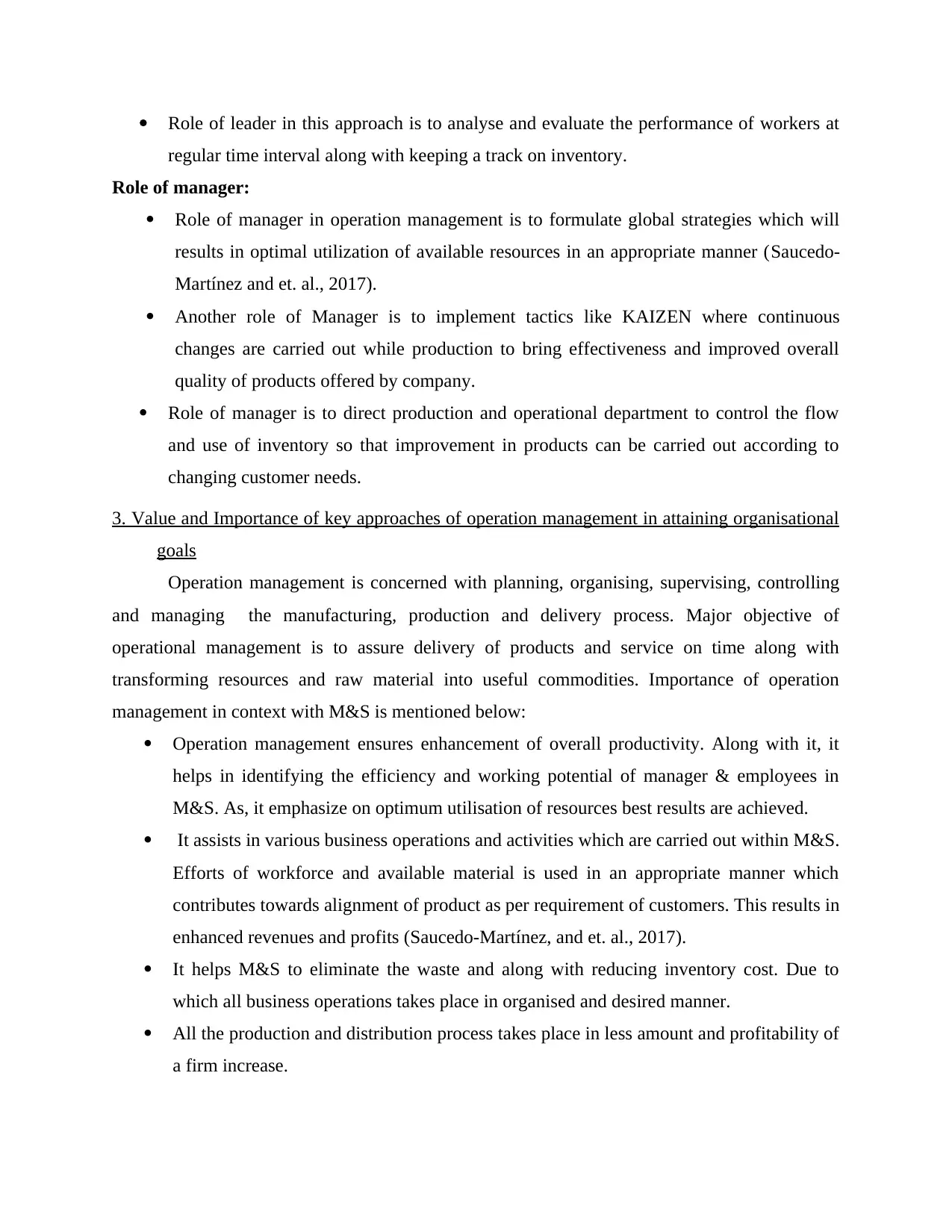
Role of leader in this approach is to analyse and evaluate the performance of workers at
regular time interval along with keeping a track on inventory.
Role of manager:
Role of manager in operation management is to formulate global strategies which will
results in optimal utilization of available resources in an appropriate manner (Saucedo-
Martínez and et. al., 2017).
Another role of Manager is to implement tactics like KAIZEN where continuous
changes are carried out while production to bring effectiveness and improved overall
quality of products offered by company.
Role of manager is to direct production and operational department to control the flow
and use of inventory so that improvement in products can be carried out according to
changing customer needs.
3. Value and Importance of key approaches of operation management in attaining organisational
goals
Operation management is concerned with planning, organising, supervising, controlling
and managing the manufacturing, production and delivery process. Major objective of
operational management is to assure delivery of products and service on time along with
transforming resources and raw material into useful commodities. Importance of operation
management in context with M&S is mentioned below:
Operation management ensures enhancement of overall productivity. Along with it, it
helps in identifying the efficiency and working potential of manager & employees in
M&S. As, it emphasize on optimum utilisation of resources best results are achieved.
It assists in various business operations and activities which are carried out within M&S.
Efforts of workforce and available material is used in an appropriate manner which
contributes towards alignment of product as per requirement of customers. This results in
enhanced revenues and profits (Saucedo-Martínez, and et. al., 2017).
It helps M&S to eliminate the waste and along with reducing inventory cost. Due to
which all business operations takes place in organised and desired manner.
All the production and distribution process takes place in less amount and profitability of
a firm increase.
regular time interval along with keeping a track on inventory.
Role of manager:
Role of manager in operation management is to formulate global strategies which will
results in optimal utilization of available resources in an appropriate manner (Saucedo-
Martínez and et. al., 2017).
Another role of Manager is to implement tactics like KAIZEN where continuous
changes are carried out while production to bring effectiveness and improved overall
quality of products offered by company.
Role of manager is to direct production and operational department to control the flow
and use of inventory so that improvement in products can be carried out according to
changing customer needs.
3. Value and Importance of key approaches of operation management in attaining organisational
goals
Operation management is concerned with planning, organising, supervising, controlling
and managing the manufacturing, production and delivery process. Major objective of
operational management is to assure delivery of products and service on time along with
transforming resources and raw material into useful commodities. Importance of operation
management in context with M&S is mentioned below:
Operation management ensures enhancement of overall productivity. Along with it, it
helps in identifying the efficiency and working potential of manager & employees in
M&S. As, it emphasize on optimum utilisation of resources best results are achieved.
It assists in various business operations and activities which are carried out within M&S.
Efforts of workforce and available material is used in an appropriate manner which
contributes towards alignment of product as per requirement of customers. This results in
enhanced revenues and profits (Saucedo-Martínez, and et. al., 2017).
It helps M&S to eliminate the waste and along with reducing inventory cost. Due to
which all business operations takes place in organised and desired manner.
All the production and distribution process takes place in less amount and profitability of
a firm increase.
Paraphrase This Document
Need a fresh take? Get an instant paraphrase of this document with our AI Paraphraser
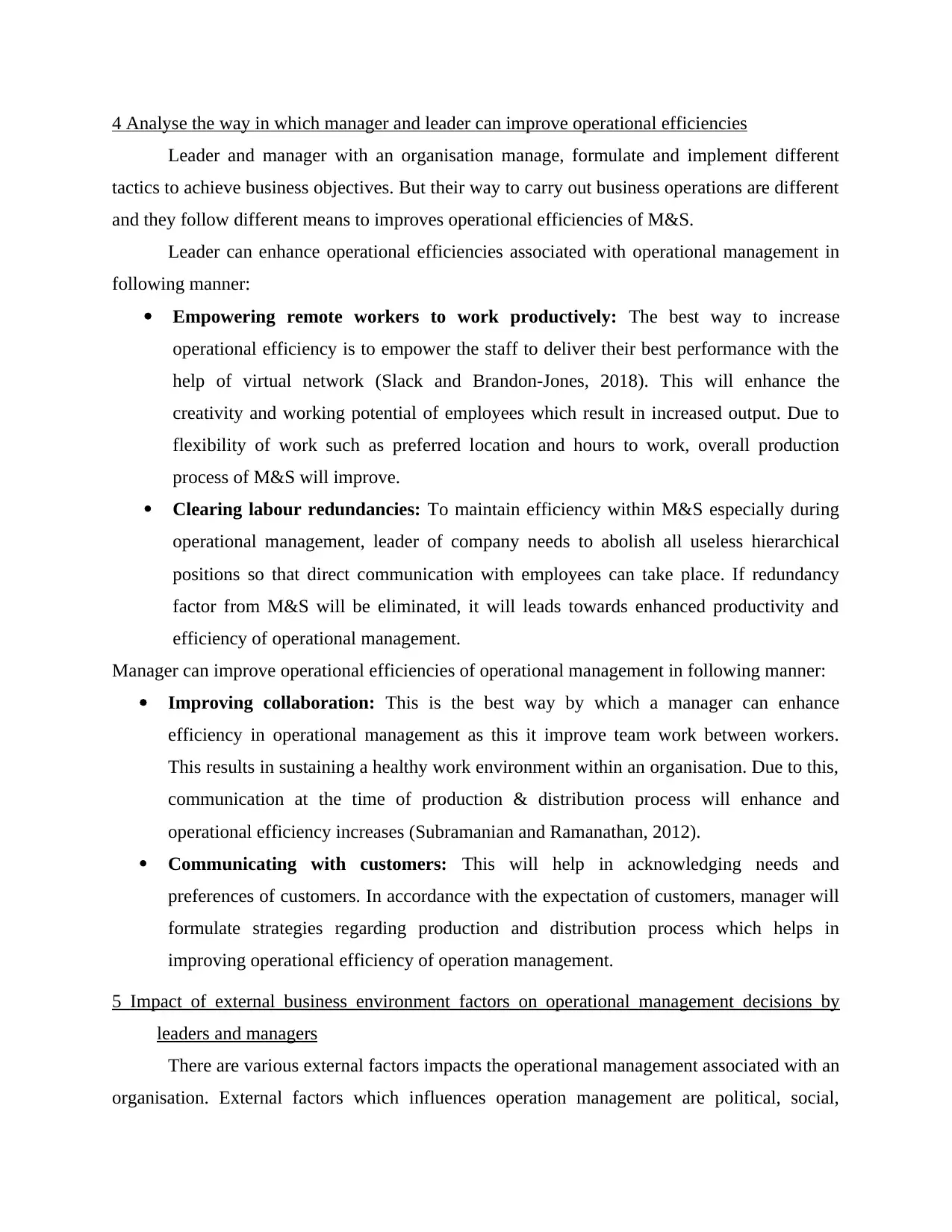
4 Analyse the way in which manager and leader can improve operational efficiencies
Leader and manager with an organisation manage, formulate and implement different
tactics to achieve business objectives. But their way to carry out business operations are different
and they follow different means to improves operational efficiencies of M&S.
Leader can enhance operational efficiencies associated with operational management in
following manner:
Empowering remote workers to work productively: The best way to increase
operational efficiency is to empower the staff to deliver their best performance with the
help of virtual network (Slack and Brandon-Jones, 2018). This will enhance the
creativity and working potential of employees which result in increased output. Due to
flexibility of work such as preferred location and hours to work, overall production
process of M&S will improve.
Clearing labour redundancies: To maintain efficiency within M&S especially during
operational management, leader of company needs to abolish all useless hierarchical
positions so that direct communication with employees can take place. If redundancy
factor from M&S will be eliminated, it will leads towards enhanced productivity and
efficiency of operational management.
Manager can improve operational efficiencies of operational management in following manner:
Improving collaboration: This is the best way by which a manager can enhance
efficiency in operational management as this it improve team work between workers.
This results in sustaining a healthy work environment within an organisation. Due to this,
communication at the time of production & distribution process will enhance and
operational efficiency increases (Subramanian and Ramanathan, 2012).
Communicating with customers: This will help in acknowledging needs and
preferences of customers. In accordance with the expectation of customers, manager will
formulate strategies regarding production and distribution process which helps in
improving operational efficiency of operation management.
5 Impact of external business environment factors on operational management decisions by
leaders and managers
There are various external factors impacts the operational management associated with an
organisation. External factors which influences operation management are political, social,
Leader and manager with an organisation manage, formulate and implement different
tactics to achieve business objectives. But their way to carry out business operations are different
and they follow different means to improves operational efficiencies of M&S.
Leader can enhance operational efficiencies associated with operational management in
following manner:
Empowering remote workers to work productively: The best way to increase
operational efficiency is to empower the staff to deliver their best performance with the
help of virtual network (Slack and Brandon-Jones, 2018). This will enhance the
creativity and working potential of employees which result in increased output. Due to
flexibility of work such as preferred location and hours to work, overall production
process of M&S will improve.
Clearing labour redundancies: To maintain efficiency within M&S especially during
operational management, leader of company needs to abolish all useless hierarchical
positions so that direct communication with employees can take place. If redundancy
factor from M&S will be eliminated, it will leads towards enhanced productivity and
efficiency of operational management.
Manager can improve operational efficiencies of operational management in following manner:
Improving collaboration: This is the best way by which a manager can enhance
efficiency in operational management as this it improve team work between workers.
This results in sustaining a healthy work environment within an organisation. Due to this,
communication at the time of production & distribution process will enhance and
operational efficiency increases (Subramanian and Ramanathan, 2012).
Communicating with customers: This will help in acknowledging needs and
preferences of customers. In accordance with the expectation of customers, manager will
formulate strategies regarding production and distribution process which helps in
improving operational efficiency of operation management.
5 Impact of external business environment factors on operational management decisions by
leaders and managers
There are various external factors impacts the operational management associated with an
organisation. External factors which influences operation management are political, social,
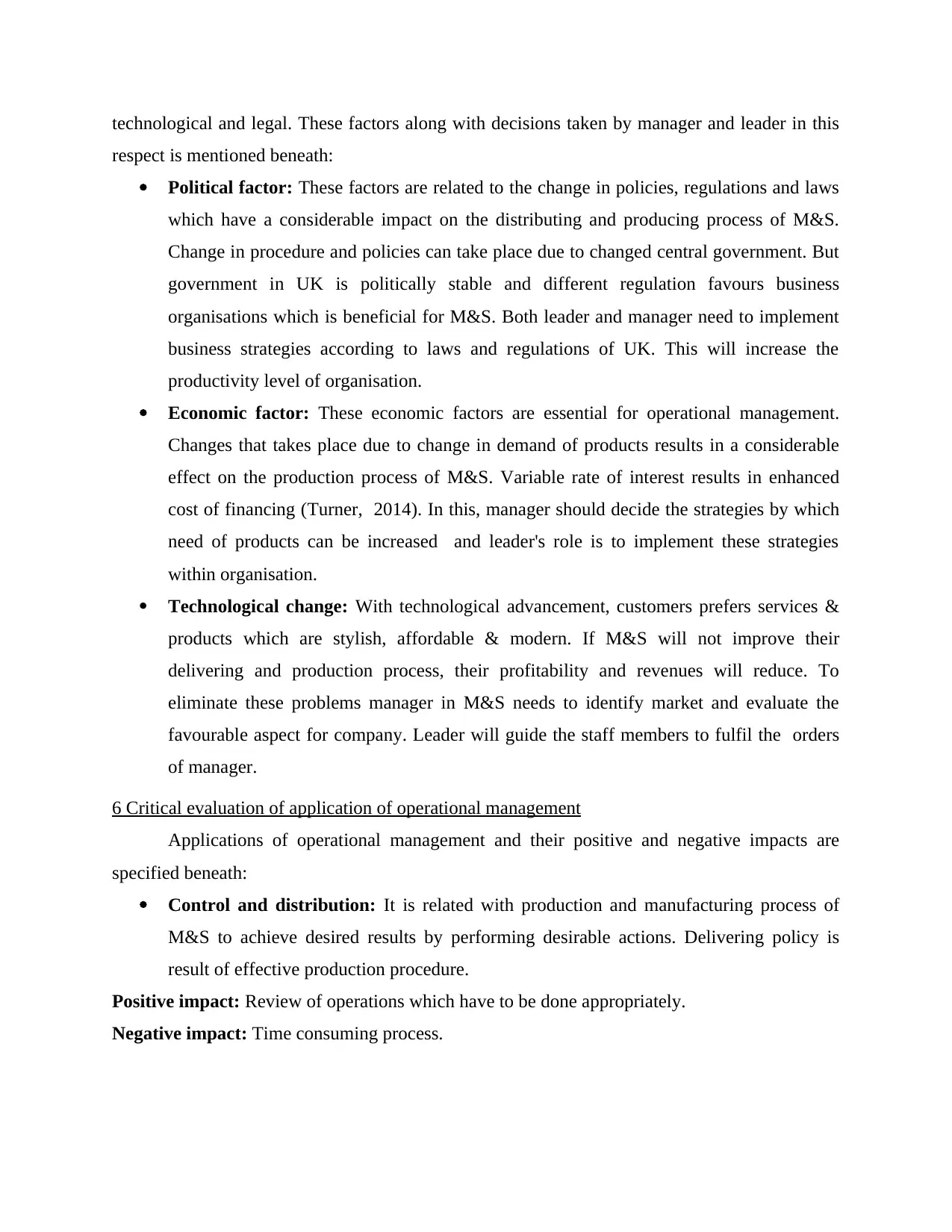
technological and legal. These factors along with decisions taken by manager and leader in this
respect is mentioned beneath:
Political factor: These factors are related to the change in policies, regulations and laws
which have a considerable impact on the distributing and producing process of M&S.
Change in procedure and policies can take place due to changed central government. But
government in UK is politically stable and different regulation favours business
organisations which is beneficial for M&S. Both leader and manager need to implement
business strategies according to laws and regulations of UK. This will increase the
productivity level of organisation.
Economic factor: These economic factors are essential for operational management.
Changes that takes place due to change in demand of products results in a considerable
effect on the production process of M&S. Variable rate of interest results in enhanced
cost of financing (Turner, 2014). In this, manager should decide the strategies by which
need of products can be increased and leader's role is to implement these strategies
within organisation.
Technological change: With technological advancement, customers prefers services &
products which are stylish, affordable & modern. If M&S will not improve their
delivering and production process, their profitability and revenues will reduce. To
eliminate these problems manager in M&S needs to identify market and evaluate the
favourable aspect for company. Leader will guide the staff members to fulfil the orders
of manager.
6 Critical evaluation of application of operational management
Applications of operational management and their positive and negative impacts are
specified beneath:
Control and distribution: It is related with production and manufacturing process of
M&S to achieve desired results by performing desirable actions. Delivering policy is
result of effective production procedure.
Positive impact: Review of operations which have to be done appropriately.
Negative impact: Time consuming process.
respect is mentioned beneath:
Political factor: These factors are related to the change in policies, regulations and laws
which have a considerable impact on the distributing and producing process of M&S.
Change in procedure and policies can take place due to changed central government. But
government in UK is politically stable and different regulation favours business
organisations which is beneficial for M&S. Both leader and manager need to implement
business strategies according to laws and regulations of UK. This will increase the
productivity level of organisation.
Economic factor: These economic factors are essential for operational management.
Changes that takes place due to change in demand of products results in a considerable
effect on the production process of M&S. Variable rate of interest results in enhanced
cost of financing (Turner, 2014). In this, manager should decide the strategies by which
need of products can be increased and leader's role is to implement these strategies
within organisation.
Technological change: With technological advancement, customers prefers services &
products which are stylish, affordable & modern. If M&S will not improve their
delivering and production process, their profitability and revenues will reduce. To
eliminate these problems manager in M&S needs to identify market and evaluate the
favourable aspect for company. Leader will guide the staff members to fulfil the orders
of manager.
6 Critical evaluation of application of operational management
Applications of operational management and their positive and negative impacts are
specified beneath:
Control and distribution: It is related with production and manufacturing process of
M&S to achieve desired results by performing desirable actions. Delivering policy is
result of effective production procedure.
Positive impact: Review of operations which have to be done appropriately.
Negative impact: Time consuming process.
⊘ This is a preview!⊘
Do you want full access?
Subscribe today to unlock all pages.

Trusted by 1+ million students worldwide
1 out of 14
Related Documents
Your All-in-One AI-Powered Toolkit for Academic Success.
+13062052269
info@desklib.com
Available 24*7 on WhatsApp / Email
![[object Object]](/_next/static/media/star-bottom.7253800d.svg)
Unlock your academic potential
Copyright © 2020–2025 A2Z Services. All Rights Reserved. Developed and managed by ZUCOL.





